 W
WAneCan was a Japanese fashion magazine published by Shogakukan. Its name derives from Ane (姉) meaning "older sister" and Can from its sister magazine CanCam. The magazine targeted at women in their mid to late twenties who have "graduated" from reading CanCam.
 W
WASCII (アスキー) was a monthly released microcomputer magazine in Japan, published by ASCII Corporation from 1977. It targeted business users who used a personal computer in their home and office, but it sometimes introduced computer games and computer music. It was also known as the Monthly ASCII (月刊アスキー) written along with the title from Vol. 2 No. 4, and distinguish with the Weekly ASCII founded in 1997. The ASCII was rebranded as the Business ASCII (ビジネスアスキー) in 2008, and ceased in 2010. Its news website and the Weekly ASCII are continuing as in 2016.
 W
WBarazoku (薔薇族) was Japan's first commercially circulated gay men's magazine. It began publication in July 1971 by Daini Shobō's owner's son and editor Bungaku Itō , although before that, there had been Adonis and Apollo, its extra issue, around 1960 serving as a members-only magazine. Barazoku was Japan's oldest and longest-running monthly magazine for gay men. However, it halted publication three times due to the publisher's financial hardships. In 2008, Itō announced that the 400th issue would be the final one. The title means "the rose tribe" in Japanese, hinted from King Laius' homosexual episodes in Greek mythology. The magazine was printed in Japanese only. Barazoku's Bungaku Itō coined the term for the Japanese lesbian community as which the slang term for lesbian yuri comes from.
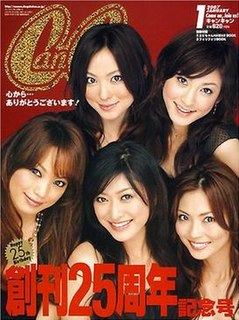 W
WCanCam is a Japanese monthly fashion magazine published by Shogakukan. Its name supposedly derives from "I Can Campus", because girls who read it are expected to become "campus leaders". The magazine was created for fashion-conscious consumers, and offers information on fashion, makeup, bags, accessories, and related topics. The magazine is targeted as a mote-kei (モテ系) fashion resource to novice office ladies as well as university students. The magazine has its headquarters in Tokyo.
 W
WCawaii! is a fashion magazine published in Taiwan, People's Republic of China, Thailand, and previously in Japan.
 W
WMonthly Classy Magazine is a Japanese women's magazine. Its title, Classy, is derived from the English adjective classy. It is estimated that the average reader of Classy magazine is between the age of 24 and 28. The magazine is known to be popular with office ladies. It is also famous among university students as a magazine for Onekei (お姉系) fashion.
 W
WCQ ham radio is a monthly amateur radio enthusiast magazine published in Japan. The magazine is published in Japanese and draws its subscription base primarily from Japan. The name of the magazine is derived from the international amateur radio call CQ, used to indicate that the station making the call is available for communications with any other station.
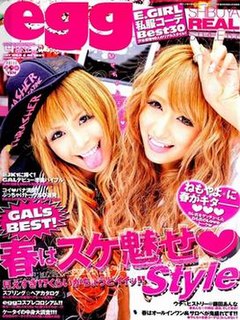 W
WEgg was a style magazine for gyaru fashion, distributed in Japan. It featured photos of ganguro girls and synopses of their tastes and popular trends. The magazine also usually had photos of the newest fashions, where to buy them, latest hairstyles, cell phones, and make up tips. It also had candid photos of ganguro girls on the streets of Japan, similar to Fruits magazine. Egg had its own models which starred in every magazine. Due to the decline of Gyaru popularity, the magazine shut down with the last issue on 31 May 2014.
 W
WFamitsu, formerly Famicom Tsūshin, is a line of Japanese video game magazines published by Kadokawa Game Linkage, a subsidiary of Kadokawa. Famitsu is published in both weekly and monthly formats as well as in the form of special topical issues devoted to only one console, video game company, or other theme. Shūkan Famitsū, the original Famitsu publication, is considered the most widely read and respected video game news magazine in Japan. From October 28, 2011 the company began releasing the digital version of the magazine exclusively on BookWalker weekly.
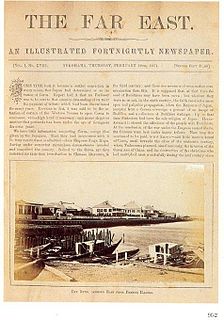 W
WThe Far East was a newsmagazine published by J. R. Black in Yokohama, Japan between 1870 and 1878. The periodical was illustrated with original, pasted-in photographs, at a time when photomechanical reproduction was still in its infancy. During its run, The Far East published approximately 750 photographs, mostly of Japan and China, by at least 20 different photographers.
 W
WFruits was a monthly Japanese street fashion magazine founded in 1997 by photographer Shoichi Aoki. Though FRUiTS covered styles found throughout Tokyo, it is associated most closely with the fashion subcultures found in Tokyo's Harajuku district. The magazine primarily focused on individual styles found outside the fashion-industry mainstream, as well as subcultures specific to Japan, such as lolita and ganguro, and local interpretations of larger subcultures like punk and goth.
 W
WG-men is a Japanese gay lifestyle brand, and formerly a monthly magazine.
 W
WGamest was a Japanese video game magazine that specialized in covering arcade games. Published by Shinseisha, it first began in May 1986 and originally published bi-monthly, later changed to be a monthly-issued magazine in the late 1980s. The magazine also featured the annual "Gamest Awards", which hands out awards to games based on user vote. The magazine had a heavy-focus on shoot 'em up arcade games, but would also cover games from other genres. Gamest originated from the bi-monthly fanzine VG2 Newsletter from the early 1980s. The magazine ran for several years, with its final issue being released in September 1999. Following the bankruptcy of publisher Shinseisha, many editors would move to ASCII and create a successor magazine, Monthly Arcadia.
 W
WGemaga was a Japanese video game magazine founded in 1984 as Beep and published by SB Creative. During its history, it was known variously as Beep, Beep! Mega Drive, Sega Saturn Magazine, Dreamcast Magazine, Dorimaga, and finally Gemaga. When it ended publication in May 2012, it was the longest-running Japanese game magazine.
 W
WGunzō (群像) is a Japanese monthly literary magazine published in Japan.
 W
WHappie Nuts was a gal fashion magazine published monthly in Japan by Inforest Publishing. Targeted at women in their late teens and early 20s, Happie Nuts was highly oriented toward the style of oneh-gal and dark-skin. Based in Tokyo, it was in circulation between 2004 and 2016.
 W
WHobby Japan Co., Ltd. is a Japanese publishing company known for publishing and releasing books, magazines, light novels, games, and collectibles. Founded in 1969, the company owns and distributes such publications as the eponymous Hobby Japan magazine, as well as Uchusen. The company has also released a number of role-playing and tabletop games, action figures related to anime and manga franchises, as well as diecast cars and related models.
 W
WI Love Mama was a gyaru fashion and lifestyle magazine published monthly in Japan by Inforest Publishing.
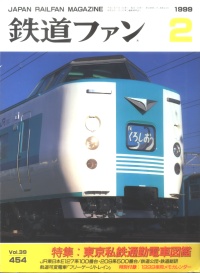 W
WJapan Railfan Magazine is a Japanese-language monthly magazine for railfans covering the mainly Japanese railways published by Koyusha. It has been published in Japan since 1961. Issues go on sale on the 21st of each month, two months before the cover month. Each copy sells for between ¥1,100 and ¥1,200 depending on the number of pages. The magazine reports on railway prototypes, complete with technical plans, photos, maps, graphs, and tables.
 W
WJapanzine is a Japan-based English-language magazine, published by Carter Witt Media. Now 20 years in publication, it is the successor magazine to The Alien and caters largely to the expatriate community in Japan. Each edition of the magazine contains a map of various Japanese cities and an entertainment guide, as well as several articles - both satirical and serious - on Japanese life. The comic strip character Charisma Man first appeared in The Alien and later in Japanzine.
 W
WJJ is a Japanese fashion and lifestyle magazine published by Kobunsha. It was established in 1975 as an extra issue of Josei Jishin, and was the first women's magazine for college students in Japan. Most readers of JJ are females between the ages of 17 and 26, and range from college students to office workers.
 W
WJunon is a monthly Japanese fashion magazine primarily directed towards teenage girls and women. The magazine began circulation in June 1973. In 1999 the circulation of the magazine was 380,000 copies. It is part of Shufu to Sekaitsusha company. The headquarters is in Tokyo.
 W
WKaizō was a Japanese general-interest magazine that started publication during the Taishō period and printed many articles of socialist content. Kaizō can be translated into English as "Reorganize", "Restructure" or "Reconstruct".
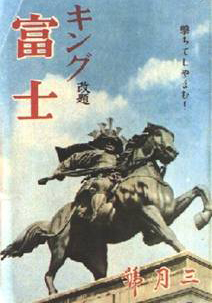 W
WKingu was a Japanese monthly general interest and entertainment magazine published in Tokyo, Japan. The magazine existed between December 1924 and January 1957. It was the first popular best-selling Japanese magazine. It was also one of two most significant magazines in mid-twentieth century Japan, the other one being Ie no Hikari.
 W
WKoakuma Ageha is a gyaru fashion and lifestyle magazine published monthly in Japan. Targeted at females in their late teens and 20s, Koakuma Ageha caters to the styles of Agejo and hime-gyaru. It also incorporates different styles into the agejo style
 W
WLove Berry was a monthly fashion magazine published in Tokyo by Tokuma Shoten. The magazine targets girls from early- to mid-teens. The magazine was known for its models. Love Berry is often abbreviated LB.
 W
WMangajin was a monthly English-language magazine for students of Japanese language and culture by Mangajin, Inc. It was distinct from many other magazines of its type in that it unabashedly embraced Japanese popular culture as a learning tool and a route towards rapid acclimation into Japanese society. Each issue featured selections from various popular manga translated into English with detailed cultural and linguistic commentary.
 W
WMen's Non-no (メンズノンノ) is a Japanese monthly men's fashion and lifestyle magazine based in Tokyo. Published by Shueisha, it is an offshoot of women's magazine Non-no.
 W
WMensEGG was a style magazine distributed in Japan aimed at young men published between 1999 and 2013. It was a counterpart of Egg magazine, which focused on Gyaru-oh fashions – it was the gyaru-oh bible. There is also Men's Egg Bitter magazine, aimed at Gyaruo aged 23 and above.
 W
WMita Bungaku (三田文学) is a Japanese literary magazine established in 1910 at Keio University that published early works by young Japanese authors such as Yōjirō Ishizaka, Kyōka Izumi, Hakushū Kitahara, Jun'ichirō Tanizaki, Takitarō Minakami, Kojima Masajirō, Ryūnosuke Akutagawa, and Ayako Sono.
 W
WMonthly Arcadia was a Japanese arcade game magazine, published by Enterbrain.
 W
WMyōjō was a monthly literary magazine published in Japan between April 1900 and November 1908. The name Myōjō can be translated as either Bright Star or Morning Star.
 W
WNamco Community Magazine NG is a video game magazine. It was distributed in Japan by Namco, quarterly from 1983 to 1986, and bimonthly from 1986 to 1993. Based on a suggestion made by company president Masaya Nakamura, its content relates to Namco video games and progressed to crafts, developer interviews, fan mail, and two manga series illustrated by Hiroshi Fuji.
 W
WNicola is a fashion magazine published in Japan by Shinchosha. This magazine targets young girls ranging from early- to mid-teens. The magazine is known for its models. Nicola was first published in 1997 and covers teen fashion trends, hair and make-up, and lifestyles. With the growing popularity of teen fashion and its models, Nicola became the top-selling fashion magazine targeting early- and mid- teen girls, with a circulation of over 231,000 a month.
 W
WNon-no is a Japanese women's fashion and lifestyle magazine published by Shueisha. The magazine is headquartered in Tokyo.
 W
WOption (オプション, Opushon in katakana and subtitled Exciting Car Magazine) is an automotive magazine founded by Daijiro Inada in 1981, to meet the demand for enthusiasts of modified Japanese cars in Japan.
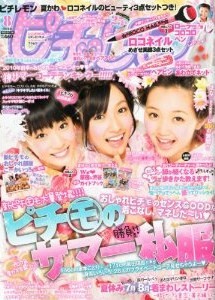 W
WPichi Lemon was a Japanese fashion magazine published by Gakken. The magazine targets girls from early- to mid-teens. The magazine was known for its models. It ceased publication in October 2015.
 W
WPopSister was a Japanese monthly gal-shibuya-kei-oriented fashion magazine published by Kadokawa Publishing & Co.. Launched in 2010 as the "older sister" magazine of Popteen, PopSister was targeted at females in their teens and early 20s.
 W
WPopteen is a monthly teenage fashion magazine published by the Kadokawa Haruki Corporation in Japan. The first issue was published on 1 October 1980 by Kadokawa Shoten. Later issues were published by Asuka Shinsha who bought the magazine for 200 million yen. In 1994 the magazine was bought by the Kadokawa Haruki Corporation for 600 million yen, and has since become its flagship publication.
 W
WRanzuki is a fashion magazine published monthly in Japan by Bunka-sha Publishing & Co.. A gal magazine, Ranzuki mainly targets women in their teens and shows its preference for dark-skin and 109 items.
 W
WRockin'On Japan, often stylized in all caps, is a monthly magazine that covers the Japanese music scene and various cultural events in Japan, such as art venues and culinary expos.
 W
WSeventeen is a monthly Japanese fashion magazine for female teenagers published by Shueisha.
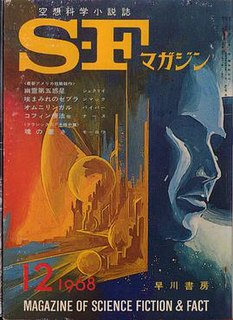 W
WS-F Magazine is a science fiction magazine published by Hayakawa Shobō in Japan. It was Japan’s first successful science fiction prozine.
 W
WMonthly Shōnen Magazine is a monthly shōnen manga magazine published in Japan by Kodansha. It was launched in 1964 under the name Bessatsu Shōnen Magazine (別冊少年マガジン). In 1969 it was retitled as Monthly Bessatsu Shōnen Magazine (月刊別冊少年マガジン) and its publication frequency increased from quarterly to monthly. After suspension in 1974 it started publishing again, in 1975 it was renamed as current magazine title.
 W
WSubaru (スバル) was a literary magazine published monthly in Japan between January 1909 and December 1913. The name of the publisher was Subaru (昴), written in kanji as opposed to the magazine title written in katakana.
 W
WVideo Boy is a Japanese monthly men's magazine which has been published since 1984. It has been called "probably the most popular AV mag in Japan" and was described by Peter Payne, proprietor of J-List as an "excellent magazine...to keep up with...AV stars". The magazine specializes in nude photos of popular Japanese AV Idols.
 W
WViVi (ヴィヴィ) is a Japanese fashion magazine published by Kodansha. It is one of Asia's top fashion magazines and is published in Japan, China, Taiwan, Hong Kong, and Thailand.
 W
WWorld Table Tennis is a Japanese monthly sports magazine devoted to the sport of table tennis. Although significantly more expensive than other Japanese table tennis magazines like Nittaku News and The Table Tennis Report, the magazine sells 700,000–800,000 copies annually, according to president Noboru Konno (今野昇), making it one of the most popular sports magazines in Japan.